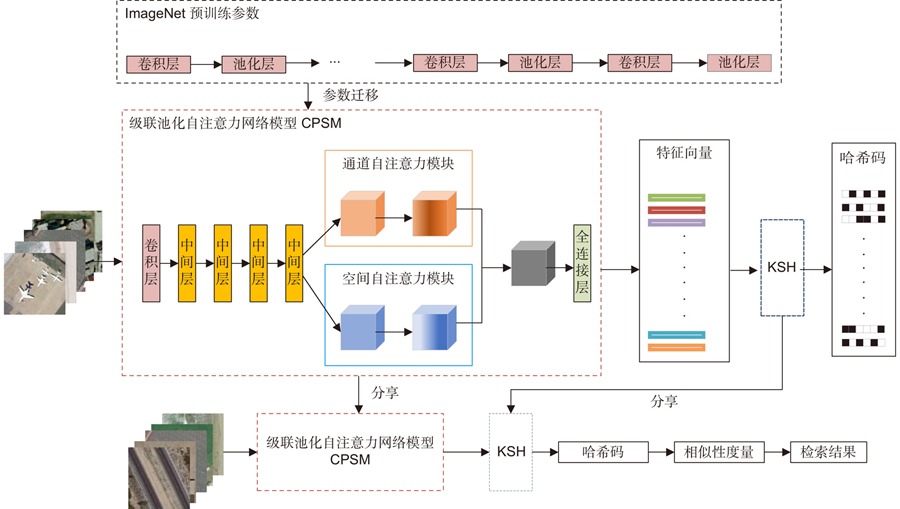光电工程, 2022, 49 (12): 220029, 网络出版: 2023-01-17
面向遥感图像检索的级联池化自注意力研究
Cascade pooling self-attention research for remote sensing image retrieval
遥感图像检索 级联池化 自注意力模块 监督核哈希 卷积神经网络 remote sensing image retrieval cascade pooling self-attention module supervised hashing with kernels convolutional neural network
摘要
高分辨率遥感图像检索中,由于图像内容复杂,细节信息丰富,以致通过卷积神经网络提取的特征难以有效表达图像的显著信息。针对该问题,提出一种基于级联池化的自注意力模块,用来提高卷积神经网络的特征表达。首先,设计了级联池化自注意力模块,自注意力在建立语义依赖关系的基础上,可以学习图像关键的显著特征,级联池化是在小区域最大池化的基础上再进行均值池化,将其用于自注意力模块,能够在关注图像显著信息的同时保留图像重要的细节信息,进而增强特征的判别能力。然后,将级联池化自注意力模块嵌入到卷积神经网络中,进行特征的优化和提取。最后,为了进一步提高检索效率,采用监督核哈希对提取的特征进行降维,并将得到的低维哈希码用于遥感图像检索。在UC Merced、AID和NWPU-RESISC45数据集上的实验结果表明,本文方法能够有效提高检索性能。
Abstract
Overview: With the development of remote sensing satellite technology and the expansion of the market in remote sensing images (RSIs), content-based remote sensing image retrieval (RSIR) plays an irreplaceable role in many fields, such as economic and social development, resource and environmental monitoring, and urban life management. However, there are complex content and rich background information in the high-resolution remote sensing images, whose features extracted by convolutional neural networks are difficult to effectively express the salient information of the RSIs. For this problem in high-resolution RSIR, a self-attention mechanism based on cascading pooling is proposed to enhance the feature expression of convolutional neural networks. Firstly, a cascade pooling self-attention module is designed. Cascade pooling uses max pooling based on a small region, and then adopts average pooling based on the max pooled feature map. Compared with traditional global pooling, cascade pooling combines the advantages of max pooling and average pooling, which not only pays attention to the salient information of the RSIs, but also retains crucial detailed information. The cascade pooling is employed in the self-attention module, which includes spatial self-attention and channel self-attention. The spatial self-attention combines self-attention and spatial attention based on location correlation, which enhances specific object regions of interest through spatial weights and weakens irrelevant background regions, to strengthen the ability of spatial feature description. The channel self-attention combines self-attention and content correlation-based channel attention, which assigns weights to different channels by linking contextual information. Each channel can be regarded as the response of one class of features, and more weights are assigned to the features with large contributions, thereby the ability to discriminate the salient features of the channel is enhanced. The cascade pooling self-attention module can learn crucial salient features of the RSIs based on the establishment of semantic dependencies. After that, the cascade pooled self-attention module is embedded into the convolutional neural networks to extract features and optimize features. Finally, in order to further increase the retrieval efficiency, supervised Hashing with kernels is applied to reduce the dimensionality of features, and then the obtained low-dimensional hash code is utilized in the RSIR. Experiments are conducted on the UC Merced, AID and NWPU-RESISC45 datasets, the mean average precisions reach 98.23%, 94.96% and 94.53% respectively. The results show that compared with the existing retrieval methods, the proposed method improves the retrieval accuracy effectively. Therefore, cascade pooling self-attention and supervised hashing with kernels optimize features from two aspects of network structure and feature compression respectively, which enhances the feature representation and improves retrieval performance.In high-resolution remote sensing image retrieval, due to the complex image content and rich detailed information, it is difficult for the features extracted by a convolutional neural network to effectively express the salient information of the image. In response to this issue, a self-attention module based on cascade pooling is proposed to improve the feature representation of convolutional neural networks. Firstly, a cascade pooling self-attention module is designed, and the self-attention module can learn key salient features of images on the basis of establishing semantic dependencies. Cascade pooling uses max pooling based on a small region, and then adopts average pooling based on the max pooled feature map. The cascade pooling is exploited in the self-attention module, which can keep important details of the image while paying attention to the salient information of the image, thereby enhancing feature discrimination. After that, the cascade pooled self-attention module is embedded into the convolutional neural network for feature optimization and extraction. Finally, in order to further improve the retrieval efficiency, supervised hashing with kernels is applied to reduce the dimensionality of features, and then the obtained low-dimensional hash code is utilized for remote sensing image retrieval. The experimental results on the UC Merced, AID and NWPU-RESISC45 data sets show that the proposed method can improve the retrieval performance effectively.
吴刚, 葛芸, 储珺, 叶发茂. 面向遥感图像检索的级联池化自注意力研究[J]. 光电工程, 2022, 49(12): 220029. Gang Wu, Yun Ge, Jun Chu, Famao Ye. Cascade pooling self-attention research for remote sensing image retrieval[J]. Opto-Electronic Engineering, 2022, 49(12): 220029.




